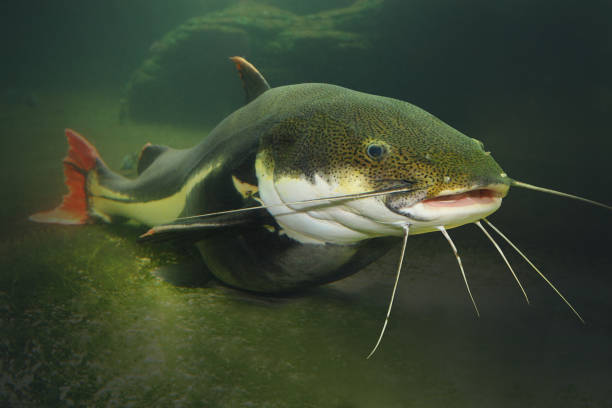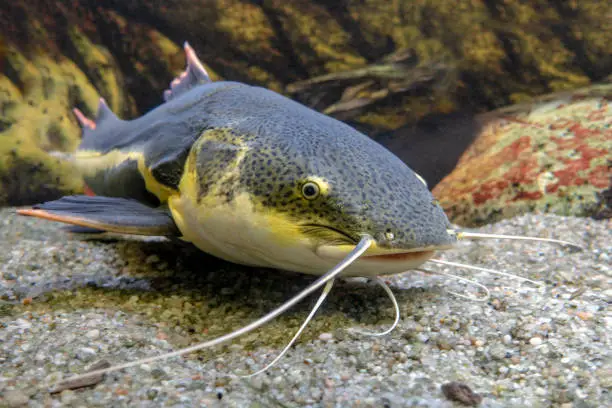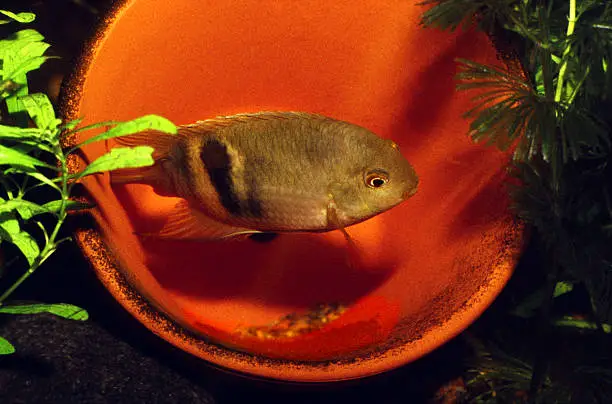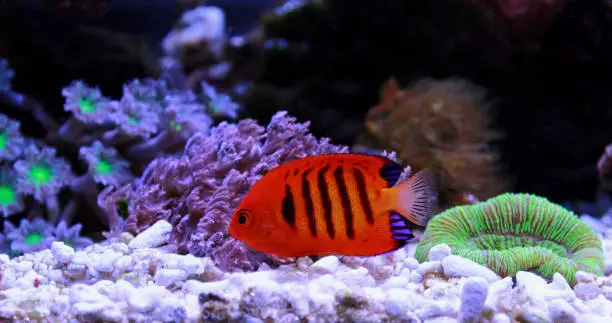Helpful Guides on each Category

Gulper Catfish are an undeniable allure for tank owners, with a sizeable, sleek body and a unique Catfish appearance that immediately seizes your attention. These fish are not only visually appealing but also exhibit a predatory nature that never fails to captivate onlookers.
Seeing them swiftly devouring their prey is amazing.
For those seeking a nocturnal presence to enhance their aquatic environment, these catfish can prove to be an excellent choice.
its unique physical traits and captivating behaviours make its allure even more.
Summary of Gulper Fish
| Scientific Name | Asterophysus batrachus |
| Family | Auchenipteridae |
| Order | Siluriformes |
| Lifespan | 10 – 15 years |
| Care Level | Moderate |
| Maximum Size | 15 Inches |
| Growth Rate | Moderate |
| Average Tank Size | 150 x 60 cm. 85-gallons |
| pH Level | 6.0 – 7.5 |
| Water Temperature | 72°F – 82°F (22°C – 28°C) |
| Hardiness | 18 – 143 ppm |
| Temperament | Aggressive |
| Tank Mates | Large, aggressive fish |
| Diseases | Common fish diseases |

- Scientific Name: Acanthicus adonis
- Other Commonly called Names: Adonis Catfish, White-Spotted Catfish
Gulper Catfish, scientifically known as Asterophysus batrachus, belongs to the family Auchenipteridae and the order Siluriformes. This order encompasses a wide range of catfish species, many of which inhabit freshwater environments around the world. Asterophysus batrachus is in the Auchenipteridae family, which includes several catfish species with unique characteristics.
When compared to other catfish species, this Catfish stands out due to its distinct physical features and behaviours. Unlike many other catfish, Gulper Catfish are renowned for their large, smooth bodies and striking white spots. This sets them apart from some of the more traditional-looking catfish varieties that feature barbels and different body shapes.
In terms of behaviour, Gulper Catfish exhibit a more predatory nature compared to some other catfish. They are known for their voracious appetite and the fascinating sight of them gulping down their prey, which can be quite mesmerizing for aquarium enthusiasts. This behaviour contrasts with the bottom-dwelling feeding habits commonly associated with many other catfish species.
Physical Characteristics of Gulper Catfish

Size
Gulper Catfish are known for their impressive size, full grown gulper catfish reach a max size of 15 inches in length.
Weight
Depending on factors such as age, diet, and habitat conditions, these adult catfish fall around a few pounds to over 8 pounds. Variations in weight are influenced by a combination of genetic factors and environmental factors like diet and available food sources.
Body Shape, Coloration
The Gulper Catfish has these very different features that set it apart from other fish species:
- Body Shape: They boast a robust and elongated body shape, which contributes to their remarkable size and presence. Their streamlined body allows for efficient movement through the water.
- Colouration: Dark base colour, often accompanied by lighter or white spots that dot their body. These white spots lend an alluring pattern to their appearance.
- Adaptations: Gulper Catfish have evolved to thrive in their native freshwater habitats. Body shape and colouration provide effective camouflage in aquatic vegetation and substrate allowing them to stalk prey without being easily spotted by potential predators.
Unique Traits: “Gulping” Behavior and Specialized Mouth Structure
One of the most intriguing traits of Gulper Catfish is their distinct “gulping” behaviour. This behaviour involves a swift and forceful inhalation of prey, allowing them to consume relatively large meals in a short span.
This behaviour is facilitated by their specialized mouth structure, which features a wide gape and powerful jaw muscles. This adaptation enables them to capture and ingest prey items that might be challenging for other fish species to consume.
Gulper Catfish Habitat and Nativity
Found in a variety of freshwater habitats, primarily inhabiting rivers, lakes, and other freshwater bodies. This catfish has adapted to thrive in a range of aquatic environments, from slow-moving rivers to calm lakes and reservoirs.
Predominant in South America, particularly in the Amazon River basin and its tributaries. Their range extends through countries like Brazil, Peru, Colombia, and Venezuela, where the diverse freshwater systems provide suitable habitats for these catfish.
This Catfish species have remarkable adaptations that allow them to thrive in diverse habitats:
- Water Flow: Their elongated body shape and strong swimming abilities enable them to navigate through different water flow conditions, from slow-moving sections of rivers to calm lake waters.
- Substrate: In river habitats, they often inhabit areas with sandy or gravelly substrate, where they can find shelter and hunt for prey.
- Camouflage: Their colouration and pattern help them blend into their surroundings, providing effective camouflage against aquatic vegetation and substrate, and aiding in ambushing prey.
- Nocturnal Behavior: Gulper Catfish are primarily nocturnal, which means they are most active during the night. This behaviour allows them to avoid predators and take advantage of the cover of darkness to hunt for food.
Feeding: What does the Gulper Fish eat?

Gulper Catfish are carnivorous aquarium fish. They dwell on a diet of live prey, such as smaller fish, crustaceans, crayfish, insects, and other aquatic organisms. This carnivorous inclination aligns with their aggressive nature and specialized hunting adaptations.
captive fish will very well accept earthworms, white fish strips, whole shrimp etc., once they are recognised as food.
Adult gulper fish do not need frequent feeding daily. 2-3 meals per week is okay.
One of the most captivating aspects of the Gulper Catfish is its distinctive “gulping” behaviour. This gulping is a rapid and forceful inhalation of prey items, often larger than what might be expected for a fish of its size. The catfish’s specialized mouth structure, which includes a wide gape and powerful jaw muscles, allows it to create a sudden vacuum-like effect that pulls in prey items. This enables the catfish to catch and consume prey that are difficult for other fish to handle.
Also, the “gulping” behaviour allows the Gulper Catfish to take advantage of larger prey items, which is more energy-efficient in terms of hunting. Rather than expending energy on capturing numerous small prey, the catfish can consume fewer but bigger meals. This is advantageous in habitats where food resources are less abundant.
Reproduction and Mating
For the mating rituals and courtship behaviours of Gulper Catfish, males display vibrant colours, flare their fins, and engage in territorial posturing to attract females and establish dominance.
Nudging, chasing, and other forms of interaction between males and females play a role in establishing pair bonds and initiating the mating process.
The female lays her adhesive eggs on a suitable substrate, such as rocks or submerged surfaces. After egg-laying, males take on the role of nest guardians. They actively protect the eggs and the surrounding area defending against potential threats.
Gulper catfish tank mates
People usually ask “Can gulper catfish live with other fish?”. Here are a few species that are great tank mates for the catfish.
- Large Cichlids like Oscars and Severums
- Other Large Catfish such as some larger Plecos
- Arowanas
- Silver Dollars
- Bichirs.
- Pacu
- Some rainbowfish species coexist with Gulper Catfish in larger aquariums with plenty of hiding spots and swimming space.
FAQs on Gulper Catfish
Gulper Catfish, under proper care and suitable conditions, can have a lifespan of around 10 to 15 years.
Factors that influence their lifespan include water quality, diet, tank size, and overall husbandry practices. Providing them with a spacious tank, appropriate water parameters, a balanced diet, and a stress-free environment can contribute to their longevity.
Full-grown Gulper Catfish can reach a size of up to 24 inches (60 cm) or even slightly larger in some cases
Yes, Gulper Catfish are known to exhibit aggressive behaviour, especially as they grow larger. While they might start out relatively peaceful when they are young, as they mature and increase in size, their predatory instincts and territorial nature become more pronounced. They might show aggression towards smaller tank mates, competing for food, and defending their territory.
In their natural habitats, young or smaller Gulper Catfish have predators, although larger adult Gulper Catfish are less likely to have natural predators due to their size and aggressive nature. However, when they are juveniles or smaller in size, they might be targeted by larger predatory fish, birds, or other aquatic creatures.




